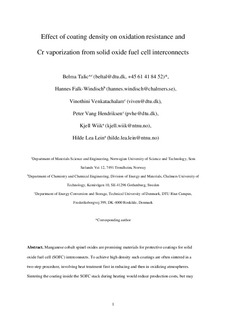| dc.contributor.author | Talic, Belma | |
| dc.contributor.author | Falk-Windisch, Hannes | |
| dc.contributor.author | Venkatachalam, Vinothini | |
| dc.contributor.author | Hendriksen, Peter Vang | |
| dc.contributor.author | Wiik, Kjell | |
| dc.contributor.author | Lein, Hilde Lea | |
| dc.date.accessioned | 2018-01-19T11:23:27Z | |
| dc.date.available | 2018-01-19T11:23:27Z | |
| dc.date.created | 2017-12-14T09:07:38Z | |
| dc.date.issued | 2017 | |
| dc.identifier.citation | Journal of Power Sources. 2017, 354 57-67. | nb_NO |
| dc.identifier.issn | 0378-7753 | |
| dc.identifier.uri | http://hdl.handle.net/11250/2478340 | |
| dc.description.abstract | Manganese cobalt spinel oxides are promising materials for protective coatings for solid oxide fuel cell (SOFC) interconnects. To achieve high density such coatings are often sintered in a two-step procedure, involving heat treatment first in reducing and then in oxidizing atmospheres. Sintering the coating inside the SOFC stack during heating would reduce production costs, but may result in a lower coating density. The importance of coating density is here assessed by characterization of the oxidation kinetics and Cr evaporation of Crofer 22 APU with MnCo1.7Fe0.3O4 spinel coatings of different density. The coating density is shown to have minor influence on the long-term oxidation behavior in air at 800 °C, evaluated over 5000 h. Sintering the spinel coating in air at 900 °C, equivalent to an in-situ heat treatment, leads to an 88% reduction of the Cr evaporation rate of Crofer 22 APU in air-3% H2O at 800 °C. The air sintered spinel coating is initially highly porous, however, densifies with time in interaction with the alloy. A two-step reduction and re-oxidation heat treatment results in a denser coating, which reduces Cr evaporation by 97%. | nb_NO |
| dc.language.iso | eng | nb_NO |
| dc.publisher | Elsevier | nb_NO |
| dc.rights | Attribution-NonCommercial-NoDerivatives 4.0 Internasjonal | * |
| dc.rights.uri | http://creativecommons.org/licenses/by-nc-nd/4.0/deed.no | * |
| dc.title | Effect of coating density on oxidation resistance and Cr vaporization from solid oxide fuel cell interconnects | nb_NO |
| dc.type | Journal article | nb_NO |
| dc.type | Peer reviewed | nb_NO |
| dc.description.version | acceptedVersion | nb_NO |
| dc.source.pagenumber | 57-67 | nb_NO |
| dc.source.volume | 354 | nb_NO |
| dc.source.journal | Journal of Power Sources | nb_NO |
| dc.identifier.doi | 10.1016/j.jpowsour.2017.04.023 | |
| dc.identifier.cristin | 1527091 | |
| dc.description.localcode | © 2017. This is the authors’ accepted and refereed manuscript to the article. Locked until 12.4.2019 due to copyright restrictions. This manuscript version is made available under the CC-BY-NC-ND 4.0 license http://creativecommons.org/licenses/by-nc-nd/4.0/ | nb_NO |
| cristin.unitcode | 194,66,35,0 | |
| cristin.unitname | Institutt for materialteknologi | |
| cristin.ispublished | true | |
| cristin.fulltext | postprint | |
| cristin.qualitycode | 1 | |

